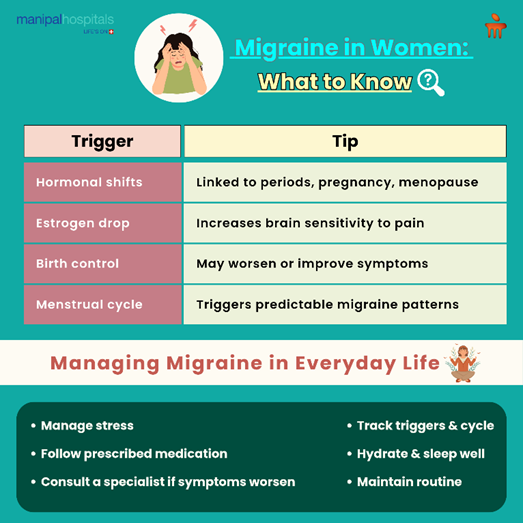
Migraines are more than just bad headaches. They can be debilitating and disruptive, especially for women. If you have a sudden, pulsating headache, usually on one side of your head, with nausea, sensitivity to light or noise, and visual changes, you're not alone. You can be suffering from migraine in females, which is much more prevalent and complicated than most people are aware of. Hormonal influences, especially oestrogen, are a key factor in precipitating migraines in women. This helps to explain why more women suffer from migraines than men, and why they tend to happen in conjunction with menstrual cycles, pregnancy, or menopause. But hormonal fluctuation isn't the only culprit. Stress, sleep deprivation, certain foods, and even fluctuations in the weather can be involved.
The good news? When you understand what causes migraines in females, you’re better equipped to manage them, and most importantly, not feel alone in your journey.
The Department of Neurology at the Manipal Hospitals, Varthur Road, has some of the best experts and is equipped with advanced technology to effectively treat symptoms related to migraine.
Synopsis
Why Do Migraines Affect Women Differently?
Let’s start with the basics. A migraine is a type of neurological disorder characterised by repeated episodes of moderate to severe headache. These episodes are usually accompanied by nausea, visual aura, or dizziness.

In women, these episodes are frequently tied to hormonal fluctuations. Oestrogen levels affect brain chemicals that control pain sensation. As these hormone levels rise or fall, such as before your period, during ovulation, or after giving birth, your chances of experiencing a migraine increase.
This clarifies why some women experience even predictable patterns, like always getting a migraine monthly, right before their period. Some women also notice a significant decrease in migraine frequency during pregnancy, then experience a return or even worsening of their symptoms postpartum. Menopause can be a new beginning, with some women experiencing relief and others developing new or more severe migraine attacks.
Common Triggers Behind Migraine in Females
So, what causes migraines in females, aside from hormones? While hormone shifts are key, they often work alongside other triggers. These may include:
-
Stress: Emotional or physical stress is one of the most reported migraine triggers.
-
Lack of Sleep: Irregular sleep patterns or poor sleep quality can heighten the risk.
-
Food and Drinks: Common culprits include chocolate, aged cheese, processed meats, red wine, and foods high in MSG or artificial sweeteners.
-
Dehydration: Even mild dehydration can set off a migraine.
-
Caffeine: Both too much caffeine and caffeine withdrawal can be triggers.
-
Weather Changes: Shifts in barometric pressure, heat, or humidity often precede migraines in sensitive individuals.
-
Sensory Overload: Bright lights, loud noises, or strong smells may initiate an attack.
Symptoms of Migraine in Females You Shouldn’t Ignore
Migraine symptoms can differ from person to person and even from one attack to another in the same individual. However, symptoms of migraine in females are most commonly reported:
|
Migraine Symptom |
How It Manifests |
|
Throbbing Headache |
Usually on one side of the head, moderate to severe in intensity |
|
Nausea and Vomiting |
May accompany the headache or precede it |
|
Sensitivity to Light & Sound |
Also known as photophobia and phonophobia, common during migraine attacks |
|
Aura |
Visual disturbances like flashing lights, zigzag patterns, or temporary vision loss |
|
Fatigue |
Extreme tiredness before, during, or after the migraine |
|
Some women report tension or tightness in the neck muscles |
|
|
Mood Changes |
Irritability or sadness before the headache begins (part of the prodrome phase) |
|
Food Cravings |
Often seen in the early phase before the headache sets in |
Some women also experience vestibular migraine, where dizziness or vertigo is more prominent than the headache itself. This can be particularly distressing as it affects your sense of balance and coordination, sometimes even without head pain.
It is important to recognise these symptoms. Once you can recognise migraine signs, you are more likely to be able to intervene early, either with rest, hydration, or medication before the pain becomes too much to bear.
Migraine Phases: It’s More Than Just the Headache
A migraine attack can be divided into stages, and knowing the stages can help you have a better handle on your migraines.
-
Prodrome: Subtle signs (mood changes, food cravings, neck stiffness) occur a day or two before a migraine.
-
Aura (in some cases): You see flashing lights, zigzag patterns, or sometimes lose part of your vision temporarily.
-
Headache Phase: This is when the actual pain kicks in. It may last 4 to 72 hours and worsen with activity.
-
Postdrome: Once the pain subsides, many women feel drained, confused, or moody for another 24–48 hours.
Managing Migraine in Everyday Life
If you’re living with migraine in females, managing your lifestyle can make a big difference. There’s no one-size-fits-all solution, but here are a few things that may help:
-
Track Your Triggers: Keep a migraine diary. Noting down what you ate, how much you slept, your stress level, and your hormonal cycle can reveal patterns.
-
Stay Hydrated: Drink enough water throughout the day.
-
Stick to a Routine: Regular sleep, meals, and exercise can help balance your body.
-
Manage Stress: Meditation, breathing exercises, or gentle yoga can reduce your stress response.
-
Medication: Your doctor may suggest preventive medications or drugs to ease symptoms during an attack.
Addressing migraine is mostly dependent on a clinical plan, as well as individual options. For those with consistent or more intense symptoms, it is important to consult a physician, and they will ultimately provide you with your treatment plan.
When Should You See a Doctor?
You shouldn’t ignore migraines, especially if:
-
They’re frequent or worsening
-
You experience neurological symptoms like slurred speech, weakness, or confusion
-
The pain starts suddenly and feels different from past migraines
-
Over-the-counter medications no longer work
Receiving the right diagnosis is vital. There may be some other conditions that can imitate migraine symptoms, so your doctor might order imaging tests or refer you to a neurologist for further evaluation.
Check Out More of Our Blogs: Take Precautions Today To Prevent Stroke Tomorrow
Conclusion
Migraines can be very debilitating. But the first step towards relief is understanding. Now that you are more informed about what's going on with headache triggers in females and where your specific headache patterns might fit, you will have a better plan of action for managing your symptoms. Make sure to note your symptoms and patterns, continue being aware of physical changes, and reach out for help when you need it. Migraines don't have to dictate your life if you have the right support. Are you interested in expert help based on your health?
Consult a top Neurologist in Bangalore at the Manipal Hospitals and take the first step toward managing migraines effectively.
FAQ's
Yes, women are almost three times as likely to suffer from migraines compared to men. This is mainly because of hormonal changes, most notably oestrogen. Hormonal fluctuations during menstruation, pregnancy, or menopause can induce or exacerbate migraine attacks in most women.
They can. Oestrogen-containing hormonal contraceptives can bring on or exacerbate migraines in some women, particularly in the hormone-free week. Yet migraines are improved by these drugs for some women.
Yes, it’s very common. These are called menstrual migraines and typically occur one or two days before your period starts. They’re linked to the sudden drop in oestrogen just before menstruation. Keeping track of your cycle and symptoms can help manage and anticipate these episodes better.
Absolutely! Even if your diet is balanced, factors like high stress levels, irregular sleep patterns, skipping meals, or dehydration can still act as migraine triggers. Women juggling work, home, and hormonal changes often find that lifestyle factors worsen their migraine symptoms.
If your migraines are frequent, interfere with your daily life, or change in pattern, such as becoming more severe or lasting longer, it’s time to see a specialist. Also, if you experience warning signs like sudden confusion, visual disturbances, or weakness on one side, seek immediate medical attention.





















 7 Min Read
7 Min Read














